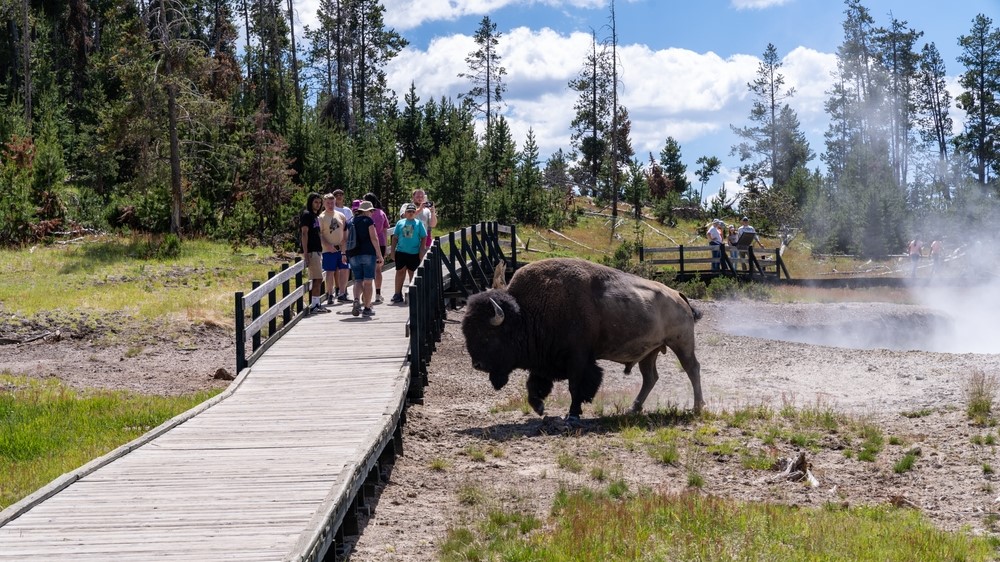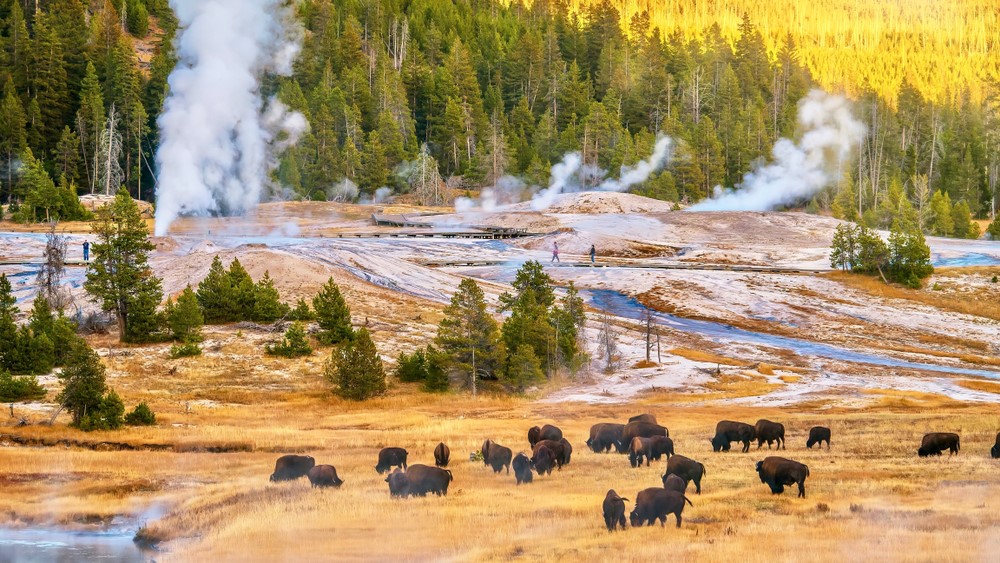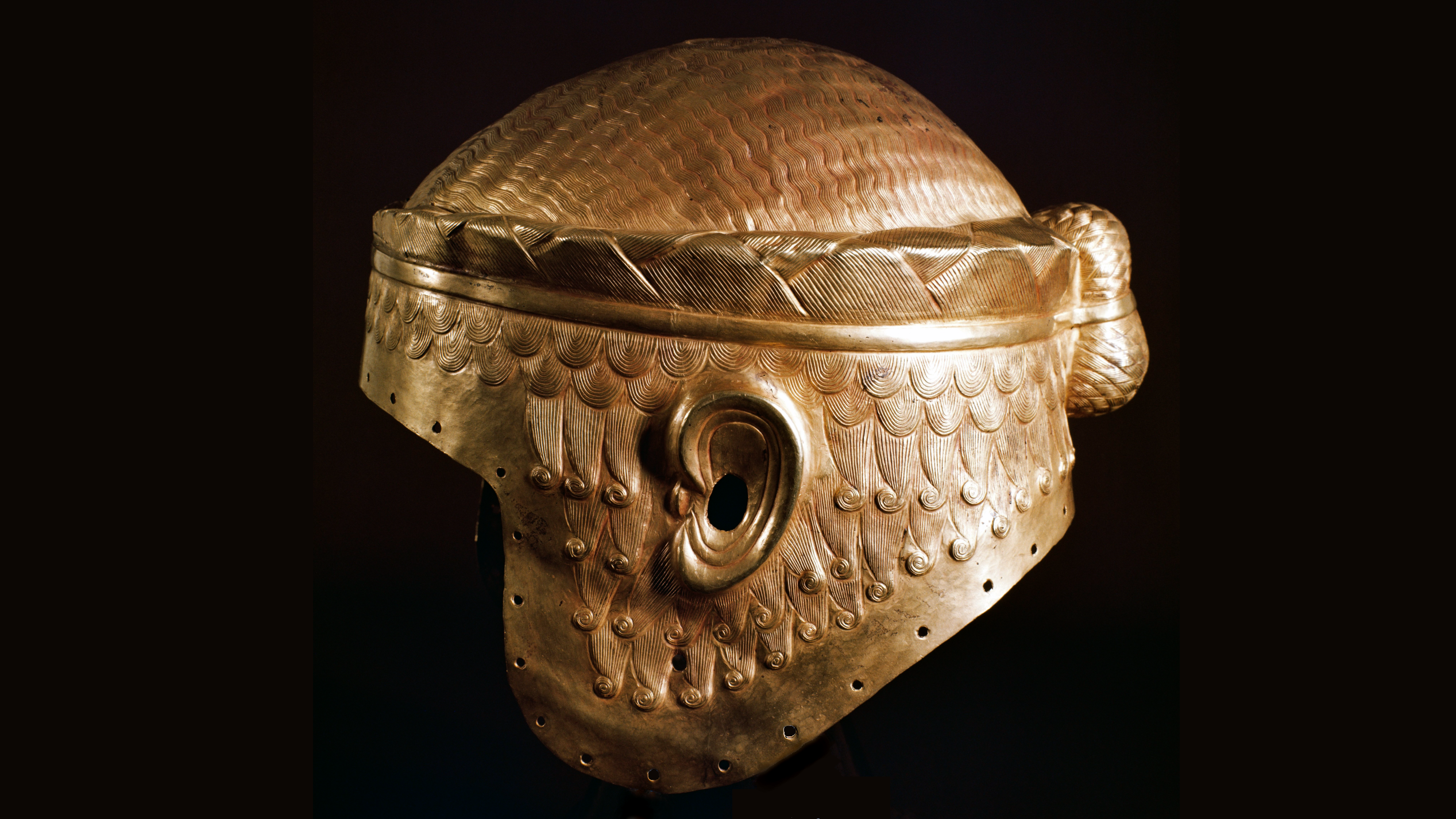Three people gored by bison in a month at Yellowstone National Park. Why do these attacks happen?
Park officials say visitors should keep a respectful distance.

Three people have been gored by bison in a single month at Yellowstone National Park, with the two most recent attacks coming just two days apart. Park officials warned visitors to be respectful of the enormous beasts' personal space, as approaching too close can provoke bison to charge.
The most recent incident occurred on Wednesday (June 29), when a 71-year-old woman from Pennsylvania was gored by a bull bison near Storm Point at Yellowstone Lake. She received non-life threatening injuries and was taken to hospital, according to a National Park Service (NPS) statement. Just two days earlier, on June 27, another bull charged at a 34-year-old man from Colorado who was walking with his family on a boardwalk near the Giant Geyser at Old Faithful. The man sustained injuries to his arm and was also taken to hospital, according to an NPS statement.
The first incident of the year occurred on May 31, when a 25-year-old woman from Ohio was attacked near a boardwalk at Black Sand Basin, just north of Old Faithful; she was gored and thrown 10 feet (3 meters) into the air, according to an NPS statement. She sustained a serious puncture wound and other minor injuries, although at the time it was mistakenly reported that she had died, according to Smithsonian Magazine.
American bison (Bison bison) are the largest land mammals in North America; males, or bulls, can grow up to 8.2 feet (2.5 m) tall at the shoulder and weigh up to 2,000 pounds (907 kilograms), and their horns can grow to a maximum length of 2 feet (0.6 m). Bison have large, protruding shoulder humps made of massive neck muscles that help the animals shovel a path through deep winter snow with their horns. The massive mammals are also extremely fast and can reach a top speed of 35 mph (56 km/h), which is around three times faster than a human can run, according to NPS.
Related: Secrets of 'mystery sandwich' beneath Yellowstone revealed in new map
Bison injure more visitors than any other animal in Yellowstone, including grizzly bears (Ursus arctos horribilis), and there is typically at least one incident every year, according to NPS. During attacks, bison commonly charge at people and gore them with their horns, before throwing them into the air with their powerful neck muscles, as seen in this video of an attack in 1992. But surprisingly, despite the animals' incredible strength and size, these attacks are rarely fatal and are likely just a warning shot from the animals.
This is not the first time Yellowstone has experienced a period of increased attacks. Between May and July 2015, five people were injured by bison, according to a 2016 report by the CDC. The highest number of attacks occurred between 1983 and 1985 when 33 people were injured, the report stated. Frequently occurring bison attacks have also been documented in other parks, such as Antelope Island State Park in Utah, where one individual was involved in two separate attacks just three months apart in 2019.
Get the world’s most fascinating discoveries delivered straight to your inbox.

However, bison only attack people when they feel threatened, which most commonly happens when people approach closer than they should. The NPS warns people to stay at least 75 feet (23 m), or the length of a tennis court, away from bison, especially around campsites, roads, walkways and car parks where the animals may be more stressed. The three people who were recently attacked in Yellowstone, as well as family members or friends who were with them at the time, were much closer to the animals than the recommended limit when they were gored, according to the NPS.
A problem in recent years has been people trying to get closer to bison — and other wildlife — to take photographs for social media. In 2015, one person who was injured by a bison later admitted they were attempting to take a selfie with the bison that attacked them.
National parks across the U.S. have seen a significant increase in visitor numbers since the easing of restrictions from the COVID-19 pandemic, which has caused a number of issues. However, it is unclear if this can be linked to bison attacks.
There were once millions of bison in America, but by the 20th century the animals were in danger of becoming completely extinct. In 1902, there were only around two dozen bison left in the park, after the U.S. Army spent decades exterminating bison in America, in an attempt to starve Native American tribes, according to NPS. But thanks to a massive conservation program, there are now 5,450 bison in the park, as of the summer of 2021, and around 30,000 wild bison across North America, according to NPS.
Today, the challenge for park officials is to manage the growing bison population. Bison are naturally free-roaming and often try to migrate across park boundaries, which can cause conflict with locals due to the destruction of property and transmission of diseases to livestock, particularly brucellosis — a bacterial disease that causes miscarriages in bison, cattle and deer. As a result, Yellowstone officials prevent the population from growing by relocating bison to other parks or by implementing small, controlled culls.
Originally published on Live Science.

Harry is a U.K.-based senior staff writer at Live Science. He studied marine biology at the University of Exeter before training to become a journalist. He covers a wide range of topics including space exploration, planetary science, space weather, climate change, animal behavior and paleontology. His recent work on the solar maximum won "best space submission" at the 2024 Aerospace Media Awards and was shortlisted in the "top scoop" category at the NCTJ Awards for Excellence in 2023. He also writes Live Science's weekly Earth from space series.
